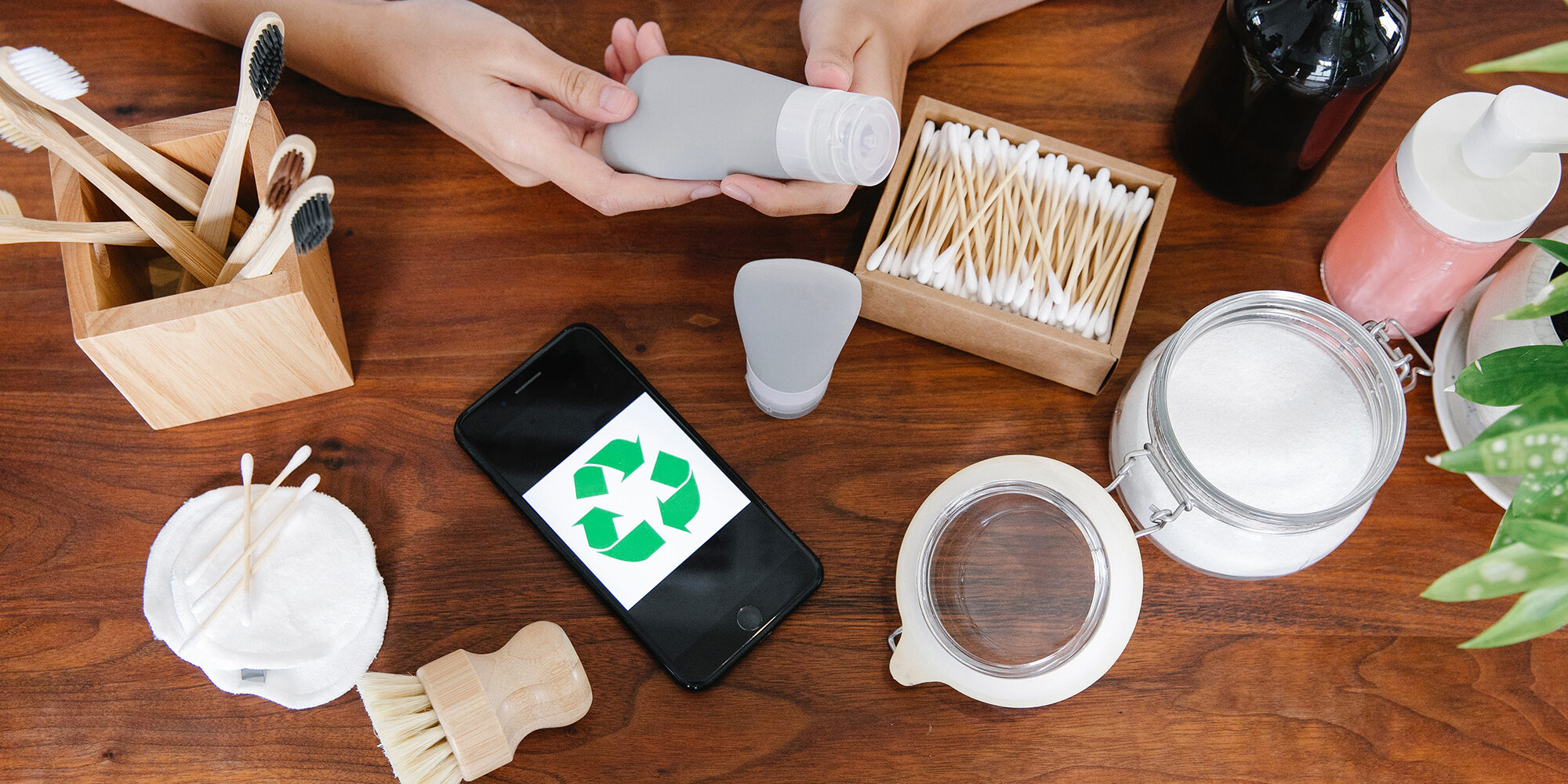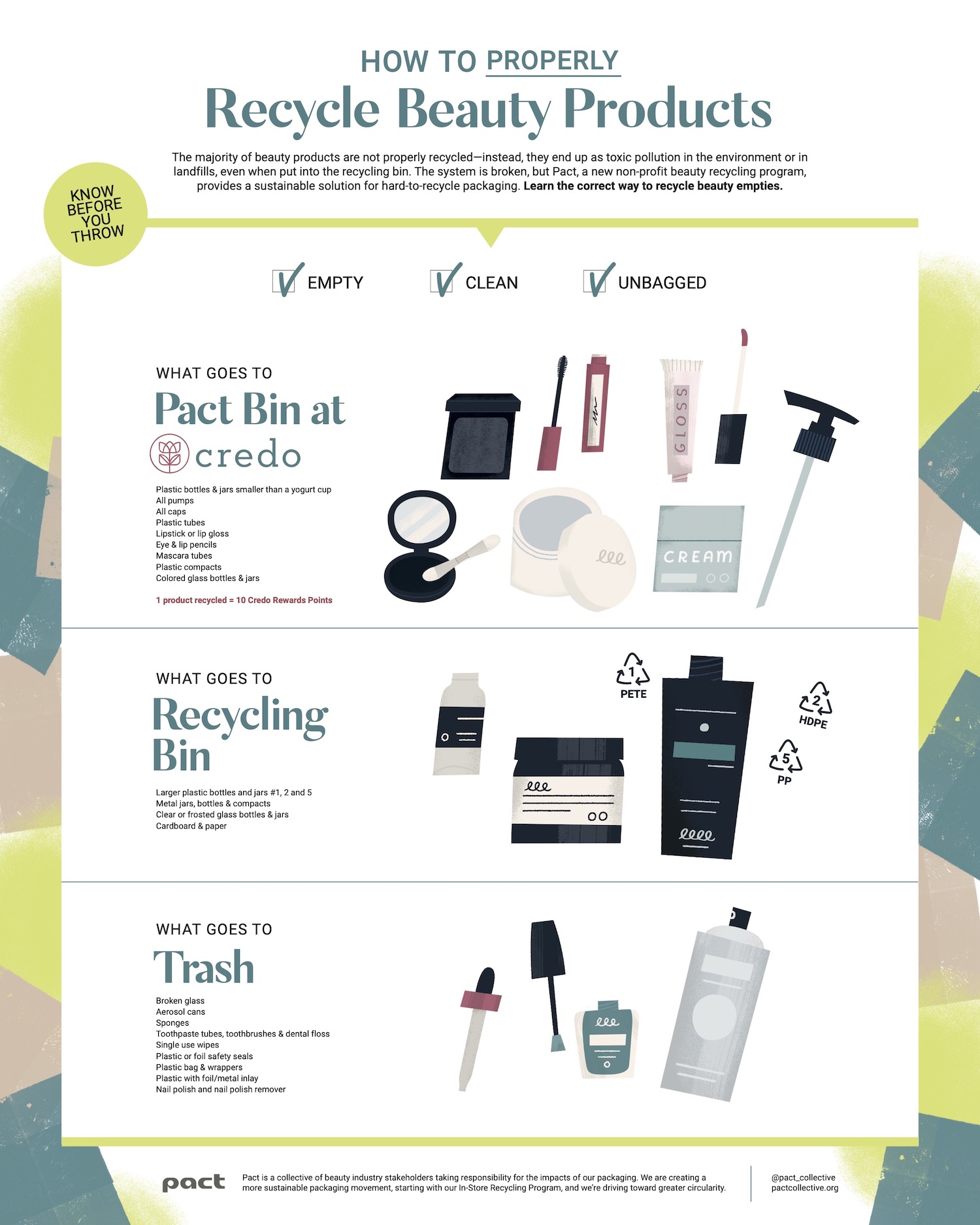
Beauty Packaging Isn’t Recycled As Much As It Should Be. Here Are Six Steps Brands Can Take To Help It Get Recycled More.
In April of this year, a Fast Company article heralded TerraCycle as “a company that can recycle just about anything.” Nearly four months later, a Vox piece dug into a lawsuit against TerraCycle, which has claimed to recycle products as different as Teva sandals and Nespresso coffee pods, asserting the company has “no hard proof that it is recycling what it says it is.” The competing looks at TerraCycle are evidence that the recycling process is complicated, and claims about it are often not what they appear to be. Even when a recycling symbol is on bottle, it doesn’t tell the full story of where the bottle ends up.
In the beauty industry, the complicated recycling process is made all the more so by various packaging components and materials, divergent capacities of the recycling infrastructure, consumer confusion and a lack of regulation. To help beauty brands as they attempt to do better at removing their merchandise from the waste stream, we chatted with beauty industry insiders and sustainability experts to identify six steps brands to create recyclable packaging.
1. ASK QUESTIONS
Early on at 3-year-old Athr Beauty, founder Tiila Abbitt partnered with TerraCycle to provide a recycling option for customers who couldn’t recycle its products where they live. Once she started asking questions about the company’s recycling scheme, though, she became suspicious. “I thought they were a good alternative, but, when I was speaking with them, I wanted to know, ‘How can you recycle all of these things that other places can’t?’ I wanted to visit the facilities to see what they were doing, and I just got a bunch of big nos,” she says. “When they don’t have the answers or they say it’s proprietary, that just makes me nervous, especially as a brand, because I don’t want to be caught up in something that can necessarily not be what it says it is in the future.”
Abbitt decided to part ways with TerraCycle and partner with Pact, a nonprofit committed to recycling hard-to-recycle beauty packaging she says was able to address her concerns. Pact tracks when items are picked up from stores, cleaned and chopped up through software from its recycling partner R3 Reverse Logistics. “They have to report on all the materials they take in, all the waste and where it goes, how it’s sorted, and we collect that information,” co-founder Victor Casale, also co-founder of MOB Beauty. He says the company plans on publishing detailed information on its site soon. Pact says the items it can’t recycle are upcycled.
2. DO YOur RESEARCH
Brandon Frank, president of Pacific Packaging Components, advises brands to design packaging with its end of life in mind. In order to do so, he stresses it’s important to have a clear understanding of the current recycling stream. While it’s hard to know definitively what is and isn’t going to be recycled because municipalities have a range of recycling rules and capabilities, Frank notes that the recycling stream is currently optimized for PET water bottles, clear glass, HDPE milk jugs, undecorated corrugate cardboard, and aluminum cans and bottles. “Everything else that isn’t exactly or very close to those types of items has a much lower likelihood of being recycled,” he says. Items smaller than an apple and all packaging with mixed materials such as pumps that include springs can’t be recycled. Frank adds that polyethylene terephthalate or PET is the most recycled plastic. High-density polyethylene or HDPE and polypropylene come in second and third.
Pact supplies brands with facts on packaging that’s easily recyclable, hard to recycle and impossible to recycle. The organization underscores that sponges, single-use wipes and nail polish generally get tossed in the trash. Casale says, “We focus on providing up-to-date factual information on beauty packaging knowing that it is an ever-evolving industry and information may change as new recycling technologies are commercialized.”

Creating a fully circular, recyclable product is a challenge because brands are often limited by available materials and budgets, suggests Casale. “Every brand can’t afford to do everything totally circular or they would not be profitable, they would die,” he says. “They just would not have the money to make it.” Pact tries to be realistic, continues Casale, so brands can “try to do the most with what they have.”
Unfortunately, it’s not always practical or possible at the moment to make beauty products out of materials that are the easiest to recycle. For instance, Abbitt explored putting mascara in paper packaging, but discovered it isn’t currently feasible. In September, Athr Beauty is releasing a mascara with a container constructed from 100% recycled ocean plastic. “We had to analyze the options and talk about what the better option is because, at the end of the day, no one’s 100% sustainable,” she says. “We’re still a brand. We’re still producing a product, but we can try to limit the amount of waste that the product leaves behind.”
3. BE UPFRONT ABOUT LIMITATIONS
In an Instagram post in June elucidating why its serum was out of stock, the skincare brand Dieux wrote, “Sustainability is a moving target.” In accompanying content, it outlined struggles it faced transitioning from virgin plastic to PCR (post-consumer recycled) materials. “To use materials that can be easily recycled by the consumer, single materials, and generally moving to Dieux better is our ethos when we approach packaging,” said the brand. “However, sustainability comes with costs we didn’t foresee.” Dieux went on to expound that it ordered under 10,000 units for a production run as a result, and they were quickly snapped up. The brand said, “For us, waiting a bit longer for a better product is worth it, and for those on our waitlist, we hope you feel the same.” The explainer became one of the brand’s most-liked posts to date. It’s garnered more than 2,600 likes and over 100 approving comments.
Lisa Leigh, founder of sustainability consulting firm Amplify the Drop, believes brands should follow Dieux’s lead, and be honest with their customers about what they can and can’t do today with their sustainability efforts. “Say that they’re working toward being better stewards and maybe right now some of their packaging isn’t environmentally friendly, I think it’s fine to announce that they’re not perfect and no brand can really be perfect,” she says. “It really is about setting goals and being transparent with your customers and saying, ‘We want to be better, and we want to improve, and this is what we’re doing going forward, and we will continue to keep you updated on our plans and what we’re looking forward to doing.’”
4. EDUCATE ALONG THE WAY
On top of updating customers on its sustainability efforts, Dieux has proceeded to educate them on how to properly recycle its packaging. “While the pump is technically recyclable, we are working on removing the metal spring for our next production run,” it has informed its customers. “Fun fact about recycling: mixed materials (mixed plastics/mixed materials like glass/plastic or glass/metal) makes things more complicated to recycle. Until there is no spring, please check with your local recycling to make sure the pump can be taken.”
Casale says founders should use sustainability not simply as a point of difference for their brands, but as a vehicle for education. “Don’t use marketing fluff,” he recommends. “Just say plain and simple, ‘This material can be recycled locally in your bin, these materials are impossible to recycle, these materials are hard to recycle, but can be recycled if you do x, y, and z.’ Be clear and specific.” He continues, “Allowing somebody to put something in a box without giving them any education doesn’t help the cause of sustainability or circularity. You need to tell them this is where this is going. Customers need to know because the customer is going to ultimately change the industry.”
Frank concurs that a straightforward approach can be effective. “Consumers, especially savvy beauty customers, would be much more friendly to a brand that says, ‘Hey, you should throw this mono material tube in the trash because that’s where it’s going to end up anyway versus saying, ‘This is recyclable, but you should check locally to see if it’s going to be recycled,’” he says. “This is still accurate and true, but, when less than 1% of recycle facilities are actually processing tubes, is that really the right advice? Are people really going to be checking locally? Yeah, you can still give them the advice to do it, but follow it up with, ‘If you don’t check locally, don’t toss us in your recycle bin. You should throw it away.’”
Brands aren’t typically as truthful as Frank would prefer, however. Speaking of admissions such as the fact that most tubes head to landfills, he says, “It’s that type of step that I think brands are unwilling to go to because all their competitors are still trying to make their packaging sound nice when the reality is every single piece of packaging is going to have a negative impact on the planet. That’s a harsh reality that we kind of all have to admit.”
5. BE CAREFUL NOT TO GREENWASH
The United States Federal Trade Commission’s Green Guides were first issued in 1992 and have been periodically revised since then to respond to trends in sustainability advertising. Lee says, “The Green Guides explain how businesses should expect consumers to interpret specific environmental claims such as recycling as well as how to qualify those claims so as to avoid misleading consumers.” The guides don’t define what sustainable claims are exactly, but they have guidance on general environmental or green claims. The FTC has brought over 60 enforcement actions related to misleading sustainability marketing or greenwashing. In those cases, Leigh says the agency will either fine brands or issue injunctions to stop their misleading activities.
Greenwashing brands run the risk of consumer backlashes. Earlier this year, K-Beauty brand Innisfree came under fire after a customer revealed its eco-friendly “paper bottle” packaging was actually a plastic bottle concealed in paper wrapping. According to reporting from The Korea Herald, the customer felt misled and filed a complaint against the product’s labeling. Frank says, “The standards are becoming even higher to where you may not be guilty of greenwashing, but, if you’re guilty of not being totally transparent, you risk losing trust equity that you built with the customer base you have and you’re jeopardizing a lot of things.”
6. UNDERSTAND Sustainability Efforts Are Ongoing
Abbitt remarks companies like Terracycle can act as Band-Aids covering up a big problem—and can even disincentivize companies from pursuing sustainable innovations. She says, “A lot of brands just do whatever packaging design they want to do and use these partnerships to kind of tick the box.” Recycling is only one element of a broader picture of sustainability. Jonina and Bradley Skaggs, co-founders of design agency Skaggs, argue refillable options are a better way to limit waste. “Overall, recycling needs to be rethought, and it’s probably better to focus on reducing and reusing than recycling,” says Jonina.
Frank maintains brands can and should take little steps toward improving their environmental footprint. “Do what you can right now and, then, constantly look for ways to improve and, over time, we will get there,” he says. “I would celebrate those little victories instead of harping on how far we have to go to solve everything.”





Leave a Reply
You must be logged in to post a comment.